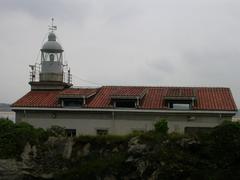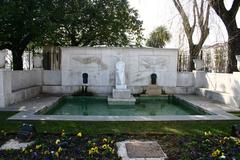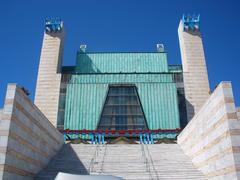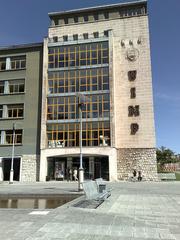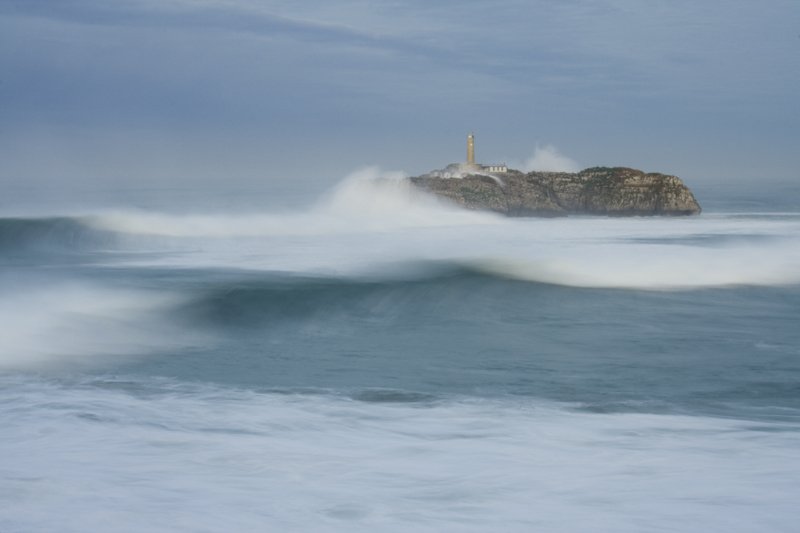
Visiting Faro de la Isla de Mouro in Santander: Hours, Tickets, and Tips
Date: 01/08/2024
Introduction
Faro de la Isla de Mouro, located at the entrance of the Bay of Santander in Cantabria, Spain, is more than just a lighthouse—it is a beacon of history, architecture, and natural beauty. Since its inauguration on February 15, 1860, the lighthouse has stood as a sentinel, guiding ships safely through the treacherous waters surrounding Mouro Island. The lighthouse’s design, reminiscent of English rock lighthouses, and its strategic importance during historical events such as the Peninsular War, add layers of historical and architectural significance to this site (Wikipedia). The island itself, once known as Isla de Mogro, was renamed due to a cartographic error, yet it remains a crucial habitat for various seabird species, making it an ecological treasure (Red Patrimonio Industrial Cantabria). This comprehensive guide aims to provide you with all the necessary information, from visiting hours and ticket prices to the best viewing spots and travel tips, ensuring that your visit to Faro de la Isla de Mouro is both enjoyable and memorable.
Table of Contents
- Introduction
- History of Faro de la Isla de Mouro
- Architectural and Technical Features
- Ecological and Environmental Significance
- Visitor Tips and Practical Information
- Cultural and Historical Context
- Getting There
- Best Viewing Spots
- Safety Tips
- Amenities and Services
- Photography Tips
- Local Attractions
- FAQ
- Conclusion
History of Faro de la Isla de Mouro
Early History and Construction
The Faro de la Isla de Mouro, located on Mouro Island at the entrance of the Bay of Santander in Cantabria, Spain, began operations on February 15, 1860. The lighthouse was constructed to guide ships safely into the bay, a critical need given the treacherous waters surrounding the island. The design of the lighthouse is reminiscent of other rock lighthouses found along the English coast, featuring a white conical tower situated in the center of a single-story keeper’s residence (Wikipedia).
Name and Historical Significance
Originally known as Isla de Mogro, the island’s name was changed to Isla de Mouro due to a transcription error by cartographer Vicente Tofiño de San Miguel in the 18th century (Red Patrimonio Industrial Cantabria). The island played a strategic role during the Peninsular War when British forces captured it from Napoleon’s troops in July 1812, facilitating Spanish naval operations (Wikipedia).
Notable Incidents
The lighthouse has witnessed several tragic events. In 1865, a storm claimed the life of a lighthouse keeper who was swept into the sea. Another incident in 1896 saw one of the two keepers die suddenly during a storm, leaving his colleague to live with the body until the weather cleared (Wikipedia). More recently, in February 1996, a severe storm damaged the lighthouse’s lighting system, rendering it inoperative for several days (Wikipedia).
Architectural and Technical Features
Design and Construction
The lighthouse is constructed from stone and features a circular plan. Its focal height is 38.7 meters above sea level, with the tower itself standing 18.39 meters tall (Red Patrimonio Industrial Cantabria). The original rotating system was designed by H. Lepaute, a collaborator of Gustave Eiffel, adding a unique technical aspect to its construction (Red Patrimonio Industrial Cantabria).
Modernization
The lighthouse’s optical system, installed in 1920, underwent significant upgrades in 2003 to ensure its continued functionality. Despite these modernizations, the lighthouse retains its historical charm and architectural integrity (Red Patrimonio Industrial Cantabria).
Ecological and Environmental Significance
Biodiversity
Mouro Island is a designated Special Protection Area (SPA) due to its importance as a habitat for seabirds, including the European storm petrel and herring gulls. The island’s waters are home to over 40 species of fish, making it a biodiversity hotspot (Wikipedia).
Conservation Efforts
In 2014, Spain’s Ministry of Agriculture, Food, and Environment declared the island a Special Protection Area to safeguard its avian population. The introduction of invasive species such as cats and rats is strictly prohibited to protect the native wildlife (Wikipedia).
World Oceans Day
Each June, Mouro Island hosts an annual event to celebrate World Oceans Day. Activities include swimming and scuba diving, with participants encircling the island to raise awareness about marine conservation (Wikipedia).
Visitor Tips and Practical Information
Visiting Hours
Faro de la Isla de Mouro can be visited year-round. However, due to its challenging accessibility, it is recommended to check the local tourism office for the most up-to-date visiting hours and conditions.
Ticket Prices
Currently, there is no ticket required to visit Faro de la Isla de Mouro. However, guided tours may have associated costs. Contact local tour operators for more details.
Accessibility
The Faro de la Isla de Mouro is one of the most inaccessible lighthouses in Cantabria. The island’s rugged terrain and the often-turbulent waters make it challenging to visit, especially during bad weather (Turismo de Cantabria). Visitors should plan their trips carefully and be prepared for potential delays or cancellations due to weather conditions.
Best Time to Visit
The best time to visit the lighthouse is during the summer months when the weather is more stable. However, even in summer, visitors should check weather forecasts and sea conditions before planning their trip (Descubre Santander).
Activities
The waters around Mouro Island are ideal for scuba diving, offering clear visibility and a rich underwater ecosystem. The island’s designation as a natural reserve ensures that its marine life is well-preserved, providing a unique diving experience (Turismo de Cantabria).
Safety Precautions
Given the island’s history of severe storms and accidents, visitors should exercise caution. It is advisable to visit the island with a guided tour that includes safety measures and emergency protocols (Wikipedia).
Contact Information
For more information or to arrange a visit, tourists can contact local tourism offices. The following numbers are available for inquiries: 942 310 708 and 690 600 825 (Turismo de Cantabria).
Nearby Attractions
While in Santander, consider visiting other historical sites such as the Palacio de la Magdalena, the Santander Cathedral, and the Centro Botín, all of which offer rich cultural experiences (Turismo de Cantabria).
Cultural and Historical Context
Local Legends and Myths
The lighthouse and the island have long been shrouded in local legends, often considered a mystical place. Tales of ghostly apparitions and mysterious shipwrecks add an eerie allure to this already fascinating site.
Getting There
Public Transportation
Visitors can easily reach Faro de la Isla de Mouro using public transportation. The nearest bus stop is Barrio Camino 27, which is a 4-minute walk from the destination. Bus lines 1, 12, 13, 3, and 4 serve this stop. For those preferring trains, the nearest station is Santander (Renfe), a 12-minute walk away. Train lines C1, C2, and C3 stop at this station. For detailed schedules and routes, the Moovit app provides real-time updates and directions.
By Car
If you prefer driving, there are parking facilities available near Faro de la Isla de Mouro. The drive offers scenic views of the coastline, making it a pleasant journey.
Best Viewing Spots
Playa del Camello
One of the best places to view Faro de la Isla de Mouro is from Playa del Camello. This beach offers spectacular photo opportunities, especially when the waves crash against the lighthouse during high tide. The parking area near the beach provides easy access for visitors. More details can be found here.
Península de La Magdalena
The Península de La Magdalena is another excellent spot for viewing the lighthouse. This location is the closest point to the Isla de Mouro, offering unobstructed views. The peninsula also features a park, a small zoo, and the historic Palacio de la Magdalena, making it a comprehensive destination for a day trip. The peninsula is open from 8:00 AM to 10:00 PM, and entry is free. For more information, visit Noradoa.
Playa de El Puntal
For a more secluded experience, head to Playa de El Puntal. This 2.5 km long sandy beach offers distant but clear views of Faro de la Isla de Mouro. Accessible by boat from Santander, this beach provides a tranquil setting away from the city’s hustle and bustle. Boat services are available year-round, with direct routes in the summer. More details are available here.
Safety Tips
Weather Conditions
Always check the weather forecast before planning your visit. The Cantabrian Sea can be unpredictable, and high waves can make certain viewing spots dangerous. Websites like AEMET provide reliable weather updates.
Footwear
Wear sturdy, non-slip footwear, especially if you plan to walk along rocky areas or beaches. The rocks can be slippery, and proper footwear will help prevent accidents.
Tide Information
Be aware of the tide schedules. High tides can limit access to certain areas and make some paths treacherous. Tide information is available on various local websites and apps.
Amenities and Services
Food and Drink
There are several cafes and restaurants near the viewing spots, especially around Playa del Camello and the Península de La Magdalena. These establishments offer a range of local delicacies, including seafood and traditional Spanish tapas.
Restrooms
Public restrooms are available at major beaches and parks. The Península de La Magdalena has well-maintained facilities, making it a convenient spot for families.
Accessibility
While some viewing spots are easily accessible, others may require a bit of a hike. The Península de La Magdalena and Playa del Camello are more accessible for those with mobility issues.
Photography Tips
Equipment
A good camera with a zoom lens is recommended to capture the lighthouse from various distances. A tripod can be useful for steady shots, especially during low light conditions.
Angles and Perspectives
Experiment with different angles and perspectives. The lighthouse looks different from various vantage points, and capturing it from multiple locations can provide a comprehensive photo collection.
Timing
Golden hour (the first hour after sunrise and the last hour before sunset) offers the best natural lighting for photography. The soft light during these times enhances the colors and textures of the lighthouse and its surroundings.
Local Attractions
Cabo Mayor Lighthouse
While visiting Faro de la Isla de Mouro, consider exploring the nearby Cabo Mayor Lighthouse. It is the oldest and most significant lighthouse in Cantabria, standing 30 meters tall on a 90-meter-high cliff. The lighthouse also houses a museum with the Sanz-Villar collection. More information can be found here.
Palacio de la Magdalena
Located on the Península de La Magdalena, this historic palace is open for tours. It offers insights into the region’s history and architecture. The palace grounds also feature a small zoo and several maritime exhibits.
Beaches
Santander boasts several beautiful beaches, including Playa del Sardinero and Playa de La Magdalena. These beaches offer various recreational activities, from swimming to beach volleyball.
FAQ
Q: What are the visiting hours for Faro de la Isla de Mouro? A: Faro de la Isla de Mouro is best viewed from afar, and there are no specific visiting hours for the lighthouse itself. However, nearby viewing spots like the Península de La Magdalena are open from 8:00 AM to 10:00 PM.
Q: Is there an entry fee to visit the viewing spots? A: Most viewing spots, including the Península de La Magdalena, are free to enter.
Q: Are there guided tours available? A: While there are no guided tours specifically for Faro de la Isla de Mouro, guided tours are available for nearby attractions like the Palacio de la Magdalena.
Conclusion
Visiting Faro de la Isla de Mouro offers a unique blend of historical intrigue, architectural beauty, and natural splendor. Whether you’re drawn by its storied past, its role in maritime navigation, or its ecological significance, this lighthouse stands as a compelling destination in Santander. From the dramatic tales of lighthouse keepers braving storms to the island’s designation as a Special Protection Area, every aspect of Faro de la Isla de Mouro enriches your understanding and appreciation of this remarkable site (Wikipedia). Practical tips, such as checking weather conditions and tide schedules, ensure a safe and enjoyable visit, while nearby attractions like the Palacio de la Magdalena and Cabo Mayor Lighthouse offer additional cultural experiences. For those interested in photography, the lighthouse provides stunning backdrops, especially during the golden hours of sunrise and sunset. As you plan your visit, remember to explore the ecological and historical facets of this iconic lighthouse, making your trip to Faro de la Isla de Mouro a truly enriching experience.
References
- Wikipedia. (n.d.). Faro de Mouro. Retrieved from https://es.wikipedia.org/wiki/Faro_de_Mouro
- Red Patrimonio Industrial Cantabria. (n.d.). Faro de la Isla de Mouro. Retrieved from https://redpatrimonioindustrialcantabria.org/portfolio-item/faro-de-la-isla-de-mouro/
- Wikipedia. (n.d.). Mouro Island. Retrieved from https://en.wikipedia.org/wiki/Mouro_Island
- Turismo de Cantabria. (n.d.). Faro Isla de Mouro. Retrieved from https://turismodecantabria.com/faro/faro-isla-de-mouro/
- Descubre Santander. (n.d.). Itinerario Peninsula de la Magdalena. Retrieved from https://descubresantander.es/itinerario-peninsula-de-la-magdalena/isla-de-mouro/
- Noradoa. (n.d.). Miradores Faros Santander. Retrieved from https://www.noradoa.com/miradores-faros-santander/
- AEMET. (n.d.). Santander Weather Forecast. Retrieved from https://www.aemet.es/en/eltiempo/prediccion/municipios/santander-id39075
- Moovit. (n.d.). Faro De La Isla De Mouro. Retrieved from https://moovitapp.com/index/en/public_transit-Faro_De_La_Isla_De_Mouro-Santander-site_28884784-4364

